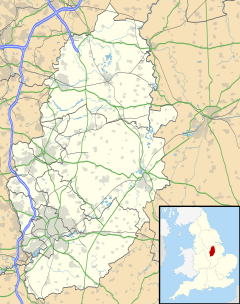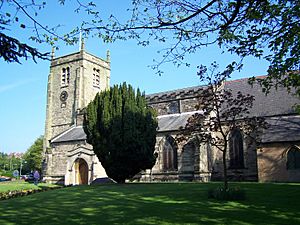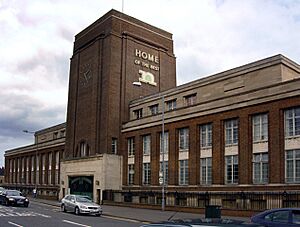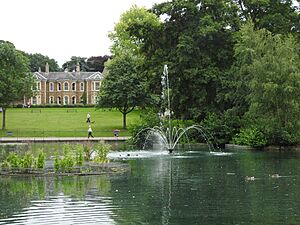Arnold, Nottinghamshire facts for kids
Quick facts for kids Arnold |
|
|---|---|
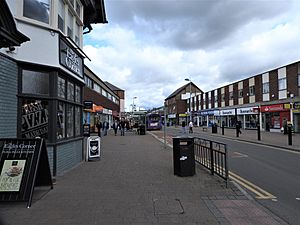 Arnold town centre view |
|
| Area | 8.148 km2 (3.146 sq mi) |
| Population | 37,768 (2011 census) |
| • Density | 4,635/km2 (12,000/sq mi) |
| OS grid reference | SK 58574 45688 |
| • London | 112.5 mi (181.1 km) |
| District |
|
| Shire county | |
| Region | |
| Country | England |
| Sovereign state | United Kingdom |
| Post town | Nottingham |
| Postcode district | NG5 |
| Dialling code | 0115 |
| Police | Nottinghamshire |
| Fire | Nottinghamshire |
| Ambulance | East Midlands |
| EU Parliament | East Midlands |
| UK Parliament |
|
Arnold (/ˈɑːr.nəld/) is a busy market town in Nottinghamshire, England. It's located just north-east of Nottingham city. Arnold has the biggest town centre in the Borough of Gedling and is a very important place for shopping and services in the north-eastern part of Greater Nottingham.
The main offices for Gedling Borough Council are in Arnold. The town has had a market since 1968. In the past, Arnold was known for its many factories that made hosiery (like socks and tights). The main police headquarters for Nottinghamshire Police have been in Arnold since 1979. In 2011, Arnold had a population of 37,768 people.
Some of the areas within Arnold include Daybrook, Woodthorpe, Redhill, Warren Hill, Killisick and Dorket Head.
Contents
What's in a Name? The Story of Arnold's Name
Arnold was first mentioned in a very old book called the Domesday Book in 1086. Back then, it was called "Ernehale." This name meant 'place visited by eagles' or 'the valley of eagles'.
Some historians think the name "Heron-hald" meant "the corner of the forest where Herons (large birds) live." Over many centuries, this name slowly changed to Eron-ald, then Ern-old, and finally Arn-old.
It's unlikely that eagles lived in Arnold itself because they prefer rocky cliffs. However, a type of eagle called the white-tailed eagle (also known as the erne) might have caught fish in the River Trent, which is about 4 miles (6.4 km) south-east of Arnold. These eagles might have flown to Arnold to rest in the old woodlands. When Anglo-Saxon people arrived around 500 A.D., they might have seen these large eagles flying and named the area 'Erne-Halh' or 'Erne-Haugh', meaning 'eagle's nook' or 'eagle's corner'.
Arnold is surrounded by hills, making it look like a bowl. This shape might also be part of how it got the name '-halh' or '-haugh'.
A Look Back: Arnold's History
Home Brewery: A Local Landmark
The Home Brewery was started in 1875 by John Robinson. It became famous for its Robin Hood logo, which you could see on its beermats. The brewery's name came from the Robinson family's farm, called Bestwood Home Farm.
The Home Brewery was a big part of Arnold for many years. It stayed independent until 1986 when it was sold to a larger company called Scottish & Newcastle. The brewery eventually closed its doors in 1996, which meant about 400 people lost their jobs.
The Brewery Building Today
The most famous building in Arnold is probably the old Home Brewery office building in Daybrook. It was built in 1936 and is now called 'Sir John Robinson House'. Today, it's used as offices for Nottinghamshire County Council.
The building is very grand, with three floors and a tall tower. It has a special design by architect Thomas Cecil Howitt. You can also see cool sculptures by Charles Doman on the front wall. These sculptures show little angels making beer! The fancy iron gates and railings are also very old and special.
King George V Park
In 1950, the Home Brewery Company Ltd. gave the land for Arnold's King George V Park. This park is a lasting memory to King George V and is always open to the public for fun and games.
The park is protected by a charity called Fields in Trust. In July 2014, a skatepark was opened at the playing field, costing £110,000.
Framework Knitting: Arnold's Old Industry
In the 1800s, Arnold was a major centre for the framework knitting industry. This was how many people made a living, creating hosiery like stockings.
However, times changed, and new machines were introduced. This led to protests by workers called the Luddite riots. On March 11, 1811, Arnold was the site of the first Luddite attacks, where 63 knitting frames were smashed. The Luddites were protesting against lower pay and worse working conditions because new fashions meant less demand for their old style of hosiery.
Arnot Hill Park and House
Arnot Hill Park was created around 1792 to be the beautiful grounds around Arnot Hill House.
Arnot Hill House
Arnot Hill House in Daybrook was once the home of the Hawksleys, an important family from Nottingham. John Hawksley, a mill owner, lived there.
One of John Hawksley's children was Thomas Hawksley, born in 1807. He became a very important civil engineer in the 1800s. Thomas Hawksley and his family were experts in public water supplies. In the early 1830s, Thomas Hawksley made big improvements to Nottingham's water supply, which helped to greatly reduce deaths from cholera.
Civic Centre
Today, the main offices for Gedling Borough Council are located in the Civic Centre at Arnot Hill Park.
Arnold's Railway Past
Arnold used to have its own railway station called 'Daybrook and Arnold' or simply 'Daybrook'. This station was an important stop on several railway lines. However, the station and lines closed between 1916 and 1964.
The old station was located on Mansfield Road (A60), where a retail park is now. You can still see parts of the old railway line, like remnants of the embankments in Arnot Hill Park. In Peggy's Park, there are special markings that show where the railway line used to run.
The closest active railway station to Arnold now is in Bulwell.
Churches in Arnold
- Arnold
- St Mary's Church, part of the Church of England, is thought to be from 1176. It's on Church Lane and is a very old and important building.
- The Roman Catholic Church of the Good Shepherd on Thackerays Lane was built in 1964. It has a modern design with a separate bell tower.
- The King's Church, formed in 1987, meets at The King's Centre on Shirley Drive. They moved into their current building in 2002.
- Cross Street Baptist Church opened in 1909 on Cross Street.
- St Mark's Church in Woodthorpe belongs to the Church of England. It was built in 1961 and is on De Vere Gardens.
- Arnoldarmy is a Salvation Army corps on High Street. They also run a second-hand shop called Sally's on Front Street.
- Eagle's Nest Church meets on Sundays at Redhill Academy on Redhill Road.
- Arnold's Kingdom Hall of Jehovah's Witnesses is on Furlong Street.
- Arnold Methodist Church – 'amc' – is on Front Street.
- Emmanuel Pentecostal Church is on Furlong Avenue.
- Arnold United Reformed Church is on Calverton Road.
- Arnold Wesleyan Reform Church is on Burford Street.
- Daybrook
- The Church of St Paul and St Timothy in Daybrook was designed between 1892 and 1896. Its tall spire and tower were added in 1897. It's on Mansfield Road.
- Daybrook Baptist Church is on Mansfield Road. Its current building was finished in 1912.
Arnold Market
Arnold Market opened in the town centre in 1968. You can visit the market on Tuesdays, Fridays, and Saturdays. There's also a flea market on Wednesdays and a farmers' market on the first Tuesday of every month. Since July 2018, Gedling Borough Council has owned and managed the market.
Fun and Games: Recreation in Arnold
Arnold Leisure Centre is on High Street, right in the middle of town. It has a swimming pool and a theatre called the Bonington Theatre. The theatre is named after a famous painter, Richard Parkes Bonington. The leisure centre was updated in 2014 with new features like a canopy outside and better changing rooms for the pool.
Connected to the leisure centre is Arnold Library. It was also updated in 2015. The improvements included adding solar panels, new lighting, and making the children's library even better.
Staying Healthy: Healthcare in Arnold
Stenhouse Medical Centre is on Furlong Street. The first doctor there was Dr Daniel Stenhouse, who started practicing in Arnold in 1886. The practice has grown a lot since then and now has six partners and looks after 12,000 patients.
Learning in Arnold: Education

- Primary schools
- Arnbrook Primary School
- Arnold Mill Primary and Nursery School
- Arnold View Primary School
- Arno Vale Junior School
- Burford Primary and Nursery School
- Coppice Farm Primary School
- Ernehale Infant School
- Ernehale Junior School
- Good Shepherd Primary Catholic Academy
- Killisick Junior School
- Richard Bonington Primary and Nursery School
- Robert Mellors Primary and Nursery School
- Secondary schools
- Arnold Hill Academy
- Christ the King Catholic Voluntary Academy
- Redhill Academy
- Other learning
Arnold also has a University of the Third Age (U3A), which is a group for older adults who want to keep learning and share their knowledge. They meet at Arnold Methodist Church.
Famous Faces: Notable People from Arnold
- Ruth Adam (1907–1977), a writer who focused on women's rights, was born in Arnold.
- Alfred Anthony (1841–1900), a cricket player for Nottinghamshire, was born in Arnold.
- George Anthony (1875–1907), also a Nottinghamshire cricketer, was born and died in Arnold.
- Henry Anthony (1873 or 1876 – 1928), another Nottinghamshire cricketer, was born in Arnold or Old Basford.
- John Barnsdale (1878–1960), a football player for Nottingham Forest F.C. and a cricketer, was born in Arnold.
- James Bodell (c. 1831–1892), a soldier, businessman, and writer in New Zealand, was born in Arnold.
- Richard Parkes Bonington (1802–1828), a famous landscape painter, was born in Arnold. The Bonington Theatre and a primary school are named after him.
- Thomas Hawksley (1807–1893), a civil engineer who made big improvements to water systems, was born at Arnot Hill House.
- Arthur Henry Knighton-Hammond (1875–1970), a watercolour painter, was born in Arnold.
- Andrea Lowe (born 1975), an actress known for roles in Coronation Street and The Tudors, was born in Arnold.
- Tom Randall (born 1981), a politician who represented the Gedling area in Parliament, lives in Arnold.
- Alison Snowden (born 1958), a voice actress and producer, was born in Arnold.
- Joseph Whitaker (1850–1932), a naturalist, was born near Arnold.
- Lisa Williamson (born 1980), a children's and young adult writer, grew up in Arnold.
- Andy Wright (born 1962), a music producer and songwriter, was born in Arnold.
Getting Around: Bus Services
- Nottingham City Transport
Lilac Line Lime Line Turquoise Line Purple Line
■ 25: Nottingham – Carlton Road – Carlton Hill – Westdale Lane – Mapperley – Arnold
■ 56: Nottingham – Mansfield Road – Plains Estate – Arnold
■ 56B: Somersby Road, Arnold – Plains Estate – Front Street, Arnold
■ 57: Nottingham – Mansfield Road – Darlton Drive, Plains Estate
■ 57X: Nottingham – Mansfield Road – Arno Vale Road – Plains Estate
■ 58: Nottingham – Mansfield Road – Arnold – Killsick
■ 59: Nottingham – Mansfield Road – Arnold – Killsick
■ 79: Nottingham – Alfreton Road – Nuthall Road – Cinderhill – Bulwell – Rise Park – Warren Hill – Bestwood Park – Arnold
■ 79A: Nottingham – Alfreton Road – Nuthall Road – Cinderhill – Bulwell – Rise Park – Top Valley – Bestwood Park – Arnold
■ 87: Nottingham – Mansfield Road – City Hospital – Redhill – Arnold
- CT4N
- 19: Bestwood Park - Arnold - Plains Estate - Mapperley - Sherwood
- Trent Barton
- The Calverton: Nottingham – Sherwood – Daybrook - Arnold - Dorket Head – Calverton (Some buses continue to Oxton and Epperstone).
- Stagecoach East Midlands
- Sherwood Arrow: Nottingham – Daybrook Square – Redhill – Ollerton – Worksop or Retford
- Pronto: Nottingham – Daybrook Square – Redhill – Papplewick - Ravenshead - Mansfield – Chesterfield
See Also
- List of King George V Playing Fields (Nottinghamshire)


